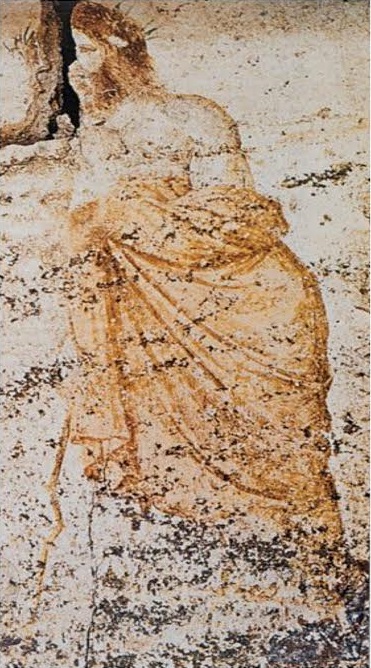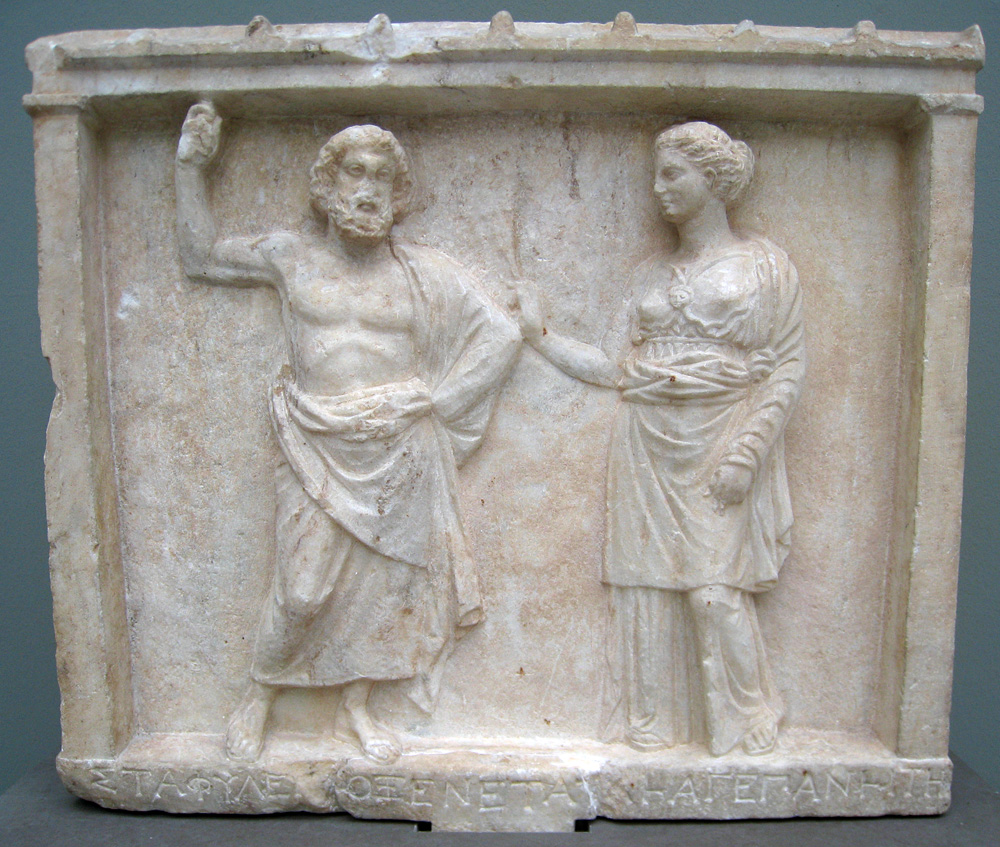|
Evanthes (mythology)
In Greek mythology, Evanthes or Euanthes (Ancient Greek: Εὐανθής means "the richly blooming") may refer to two different individuals: * Evanthes, son of Oenopion, Eustathius on Homer, ''Odyssey'' 1623.44 as cited in Hesiod, '' Ehoiai'' fr. 86 son of Ariadne and Dionysus. His mother was probably the nymph Helice and his only sister was Merope (Aero) who was raped by the giant Orion. Together with his brothers, Talus, Melas, Salagus and Athamas, they followed their father when he sailed from Crete to settle in Chios.Pausanias7.4.8/ref> Other sources makes Euanthes a son of Dionysus and Ariadne and brother to Oenopion, Thoas, Staphylus, Latromis and Tauropolis. He was also said to be one the generals of Rhadamanthys who was presented by the later with the city of Maroneia. Euanthes had a son Maron who was encountered by Odysseus in Ismarus, land of the Ciconians. * Evanthes, a Phrygian who fought on Aeneas' side in Italy. He was killed by Mezentius, king of the Etrusc ... [...More Info...] [...Related Items...] OR: [Wikipedia] [Google] [Baidu] |
Greek Mythology
A major branch of classical mythology, Greek mythology is the body of myths originally told by the Ancient Greece, ancient Greeks, and a genre of Ancient Greek folklore. These stories concern the Cosmogony, origin and Cosmology#Metaphysical cosmology, nature of the world, the lives and activities of List of Greek mythological figures, deities, Greek hero cult, heroes, and List of Greek mythological creatures, mythological creatures, and the origins and significance of the ancient Greeks' own cult (religious practice), cult and ritual practices. Modern scholars study the myths to shed light on the religious and political institutions of ancient Greece, and to better understand the nature of myth-making itself. The Greek myths were initially propagated in an oral tradition, oral-poetic tradition most likely by Minoan civilization, Minoan and Mycenaean Greece, Mycenaean singers starting in the 18th century BC; eventually the myths of the heroes of the Trojan War and its after ... [...More Info...] [...Related Items...] OR: [Wikipedia] [Google] [Baidu] |
Crete
Crete ( el, Κρήτη, translit=, Modern: , Ancient: ) is the largest and most populous of the Greek islands, the 88th largest island in the world and the fifth largest island in the Mediterranean Sea, after Sicily, Sardinia, Cyprus, and Corsica. Crete rests about south of the Greek mainland, and about southwest of Anatolia. Crete has an area of and a coastline of 1,046 km (650 mi). It bounds the southern border of the Aegean Sea, with the Sea of Crete (or North Cretan Sea) to the north and the Libyan Sea (or South Cretan Sea) to the south. Crete and a number of islands and islets that surround it constitute the Region of Crete ( el, Περιφέρεια Κρήτης, links=no), which is the southernmost of the 13 top-level administrative units of Greece, and the fifth most populous of Greece's regions. Its capital and largest city is Heraklion, on the north shore of the island. , the region had a population of 636,504. The Dodecanese are located to the no ... [...More Info...] [...Related Items...] OR: [Wikipedia] [Google] [Baidu] |
Philostratus Of Lemnos
Philostratus of Lemnos ( grc-gre, Φιλόστρατος ὁ Λήμνιος; c. 190 – c. 230 AD), also known as Philostratus the Elder to distinguish him from Philostratus the Younger who was also from Lemnos, was a Greek sophist of the Roman imperial period. He was probably a nephew of the sophist Philostratus of Athens, and is credited with two books formerly attributed to his uncle. Works '' Eikones'' (, ''Images'' or ''Imagines'') is ostensibly a description of 64 pictures in a Neapolitan gallery. Goethe, Welcker, Brunn, E. Bertrand and Helbig, among others, have held that the descriptions are of actually existing works of art, while Heyne and Friederichs deny this. In any case they are interesting as showing the way in which ancient artists treated mythological and other subjects, and are written with artistic knowledge and in attractive language. A second series of ''Imagines'' was produced by his grandson. Philostratus the Younger certainly wrote the 2nd series of '' ... [...More Info...] [...Related Items...] OR: [Wikipedia] [Google] [Baidu] |
Maron (mythology)
In Greek mythology, Maron () or Maro (; Ancient Greek: Μάρων, ''gen.'' Μάρωνος) was the hero of sweet wine. He was an experienced man in the cultivation of the vine. Family Maron was the son of Euanthes Philostratus the Athenian, ''Heroicus'' 680 Eustathius on Homer, ''Odyssey'' 1623.44 as cited in Hesiod, '' Ehoiai'' fr. 86 (some also call him a son of Oenopion, Silenus, and a pupil of Silenus), and grandson of Dionysus and Ariadne. As the son of Bacchus and the Cretan princess, Maron was brother to Thoas, Staphylos and Eunous. Mythology Maron was mentioned among the companions of Dionysus. The city Maroneia in Thrace was named after its founder Maron; there he was venerated in a sanctuary. The god Osiris (Dionysus) left Maron, who was now old, in that land to supervise the culture of the plants which he introduced to the a city. "Maron who haunts the vines at Ismaros and, by planting and pruning them, makes them produce sweet wine, especially when farmers see Ma ... [...More Info...] [...Related Items...] OR: [Wikipedia] [Google] [Baidu] |
Diodorus Siculus
Diodorus Siculus, or Diodorus of Sicily ( grc-gre, Διόδωρος ; 1st century BC), was an ancient Greek historian. He is known for writing the monumental universal history ''Bibliotheca historica'', in forty books, fifteen of which survive intact, between 60 and 30 BC. The history is arranged in three parts. The first covers mythic history up to the destruction of Troy, arranged geographically, describing regions around the world from Egypt, India and Arabia to Europe. The second covers the time from the Trojan War to the death of Alexander the Great. The third covers the period to about 60 BC. ''Bibliotheca'', meaning 'library', acknowledges that he was drawing on the work of many other authors. Life According to his own work, he was born in Agyrium in Sicily (now called Agira). With one exception, antiquity affords no further information about his life and doings beyond his written works. Only Jerome, in his ''Chronicon'' under the "year of Abraham 1968" (49 BC), w ... [...More Info...] [...Related Items...] OR: [Wikipedia] [Google] [Baidu] |
Maroneia
Maroneia ( el, Μαρώνεια) is a village and a former municipality in Rhodope regional unit, East Macedonia and Thrace, Greece. Since the 2011 local government reform it is part of the municipality Maroneia-Sapes, of which it is a municipal unit. The municipal unit has an area of 287.155 km2. Population 6,350 (2011). The seat of the municipality was in Xylagani. History In legend, it was said to have been founded by Maron, a son of Dionysus, or even a companion of Osiris. According to Pseudo-Scymnus it was founded by Chios in the fourth year of the fifty-ninth Olympiad (540 BCE). According to Pliny, its ancient name was Ortagures or Ortagurea. It was located on the hill of Agios Charalampos, and archaeological findings date it as a much older and as a pure Thracian city. Herodotus says it belonged to the Cicones. Maroneia was close to the Ismaros mentioned by Homer in the ''Odyssey''. Some scholars identify Maroneia with his Ismaros. Homer has Odysseus plundering ... [...More Info...] [...Related Items...] OR: [Wikipedia] [Google] [Baidu] |
Rhadamanthus
In Greek mythology, Rhadamanthus () or Rhadamanthys ( grc, Ῥαδάμανθυς) was a wise king of Crete. As the son of Zeus and Europa he was considered a demigod. His name means "showing stern and inflexible judgement". He later became one of the judges of the dead and an important figure in Greek mythology. Family Rhadamanthus was, according to mythology, the son of Zeus and Europa and brother to Sarpedon and Minos (also a king and later a judge of the dead). Together with his brother, Rhadamanthus was raised by Asterion, their stepfather. He had two sons, Gortys (associated with Gortyn, Crete) and Erythrus (founder of Erythrae). Other sources (e.g. Plutarch, ''Theseus'' 20) credit Rhadamanthys rather than Dionysus as the husband of Ariadne, and the father of Oenopion, Staphylus and Thoas. In this account, Ariadne was the daughter of Minos, Rhadamanthys' brother; another Ariadne was the daughter of Minos's grandson and namesake, who features in Theseus's legend and was ... [...More Info...] [...Related Items...] OR: [Wikipedia] [Google] [Baidu] |
Apollonius Of Rhodes
Apollonius of Rhodes ( grc, Ἀπολλώνιος Ῥόδιος ''Apollṓnios Rhódios''; la, Apollonius Rhodius; fl. first half of 3rd century BC) was an ancient Greek author, best known for the ''Argonautica'', an epic poem about Jason and the Argonauts and their quest for the Golden Fleece. The poem is one of the few extant examples of the epic genre and it was both innovative and influential, providing Ptolemaic Egypt with a "cultural mnemonic" or national "archive of images", and offering the Latin poets Virgil and Gaius Valerius Flaccus a model for their own epics. His other poems, which survive only in small fragments, concerned the beginnings or foundations of cities, such as Alexandria and Cnidus places of interest to the Ptolemies, whom he served as a scholar and librarian at the Library of Alexandria. A literary dispute with Callimachus, another Alexandrian librarian/poet, is a topic much discussed by modern scholars since it is thought to give some insight into t ... [...More Info...] [...Related Items...] OR: [Wikipedia] [Google] [Baidu] |
Scholia
Scholia (singular scholium or scholion, from grc, σχόλιον, "comment, interpretation") are grammatical, critical, or explanatory comments – original or copied from prior commentaries – which are inserted in the margin of the manuscript of ancient authors, as glosses. One who writes scholia is a scholiast. The earliest attested use of the word dates to the 1st century BC. History Ancient scholia are important sources of information about many aspects of the ancient world, especially ancient literary history. The earliest scholia, usually anonymous, date to the 5th or 4th century BC (such as the ''scholia minora'' to the ''Iliad''). The practice of compiling scholia continued to late Byzantine times, outstanding examples being Archbishop Eustathius' massive commentaries to Homer in the 12th century and the ''scholia recentiora'' of Thomas Magister, Demetrius Triclinius and Manuel Moschopoulos in the 14th. Scholia were altered by successive copyists an ... [...More Info...] [...Related Items...] OR: [Wikipedia] [Google] [Baidu] |
Staphylus (son Of Dionysus)
In Greek mythology, Staphylus (; Ancient Greek: Στάφυλος, 'grape cluster') was the son of wine-god Dionysus and Ariadne. His brothers include Oenopion, Thoas, Peparethus, Euanthes and Phanus. Another source stated that Staphylus's brothers were Maron, Thoas and Eunous. Mythology Staphylus and his brother Phanus are counted among the Argonauts. As one of Rhadamanthys' generals, he was the founder of the colony of Peparethos on the island of Skopelos, in the Northern Sporades island chain. Staphylus dwelt in Naxos and was married to Chrysothemis, by whom he had three daughters: Rhoeo, who was a lover to Apollo, Parthenos, and Molpadia or Hemithea.Diodorus Siculus, ''Bibliotheca historica'' 5.62.3 The latter became the mother of Basileus with Lyrcus, after Lyrcus had made a journey to the oracle at Didyma. Staphylus is said to have enticed Lyrcus into too much drinking of wine and then, when Lyrcus' senses were dulled by drunkenness, united him with Hemithea. Part ... [...More Info...] [...Related Items...] OR: [Wikipedia] [Google] [Baidu] |






